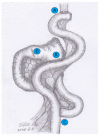Clinical comparison of antrum-preserving double tract reconstruction vs roux-en-Y reconstruction after gastrectomy for Siewert types II and III adenocarcinoma of the esophagogastric junction
- PMID: 26379405
- PMCID: PMC4566393
- DOI: 10.3748/wjg.v21.i34.9999
Clinical comparison of antrum-preserving double tract reconstruction vs roux-en-Y reconstruction after gastrectomy for Siewert types II and III adenocarcinoma of the esophagogastric junction
Abstract
Aim: To explore a reasonable method of digestive tract reconstruction, namely, antrum-preserving double-tract reconstruction (ADTR), for patients with adenocarcinoma of the esophagogastric junction (AEG) and to assess its efficacy and safety in terms of long-term survival, complications, morbidity and mortality.
Methods: A total of 55 cases were retrospectively collected, including 18 cases undergoing ADTR and 37 cases of Roux-en-Y reconstruction (RY) for AEG (Siewert types II and III) at North Sichuan Medical College. The cases were divided into two groups. The clinicopathological characteristics, perioperative outcomes, postoperative complications, morbidity and overall survival (OS) were compared for the two different reconstruction methods.
Results: Basic characteristics including sex, age, body mass index (BMI), Siewert type, pT status, pN stage, and lymph node metastasis were similar in the two groups. No significant differences were found between the two groups in terms of perioperative outcomes (including the length of postoperative hospital stay, operating time, and intraoperative blood loss) and postoperative complications (consisting of anastomosis-related complications, wound infection, respiratory infection, pleural effusion, lymphorrhagia, and cholelithiasis). For the ADTR group, perioperative recovery indexes such as time to first flatus (P = 0.002) and time to resuming a liquid diet (P = 0.001) were faster than those for the RY group. Moreover, the incidence of reflux esophagitis was significantly decreased compared with the RY group (P = 0.048). The postoperative morbidity and mortality rates for overall postoperative complications and the rates of tumor recurrence and metastasis were not significantly different between the two groups. Survival curves plotted using the Kaplan-Meier method and compared by log-rank test demonstrated similar outcomes for the ADTR and RY groups. Multivariate analysis of significantly different factors that presented as covariates on Cox regression analysis to assess the survival and recurrence among AEG patients showed that age, gender, BMI, pleural effusion, time to resuming a liquid diet, lymphorrhagia and tumor-node-metastasis stage were important prognostic factors for OS of AEG patients, whereas the selection of surgical method between ADTR and RY was shown to be a similar prognostic factor for OS of AEG patients.
Conclusion: ADTR by jejunal interposition presents similar rates of tumor recurrence, metastasis and long-term survival compared with classical reconstruction with RY esophagojejunostomy; however, it offers considerably improved near-term quality of life, especially in terms of early recovery and decreased reflux esophagitis. Thus, ADTR is recommended as a worthwhile digestive tract reconstruction method for Siewert types II and III AEG.
Keywords: Adenocarcinoma of the esophagogastric junction; Antrum-preserving double-tract reconstruction; Overall survival; Roux-Y reconstruction; Total gastrectomy.
Figures




References
-
- Mariette C, Piessen G, Briez N, Gronnier C, Triboulet JP. Oesophagogastric junction adenocarcinoma: which therapeutic approach? Lancet Oncol. 2011;12:296–305. - PubMed
-
- Hasegawa S, Yoshikawa T. Adenocarcinoma of the esophagogastric junction: incidence, characteristics, and treatment strategies. Gastric Cancer. 2010;13:63–73. - PubMed
-
- Chung JW, Lee GH, Choi KS, Kim DH, Jung KW, Song HJ, Choi KD, Jung HY, Kim JH, Yook JH, et al. Unchanging trend of esophagogastric junction adenocarcinoma in Korea: experience at a single institution based on Siewert’s classification. Dis Esophagus. 2009;22:676–681. - PubMed
Publication types
MeSH terms
LinkOut - more resources
Full Text Sources
Other Literature Sources
Medical
Research Materials

